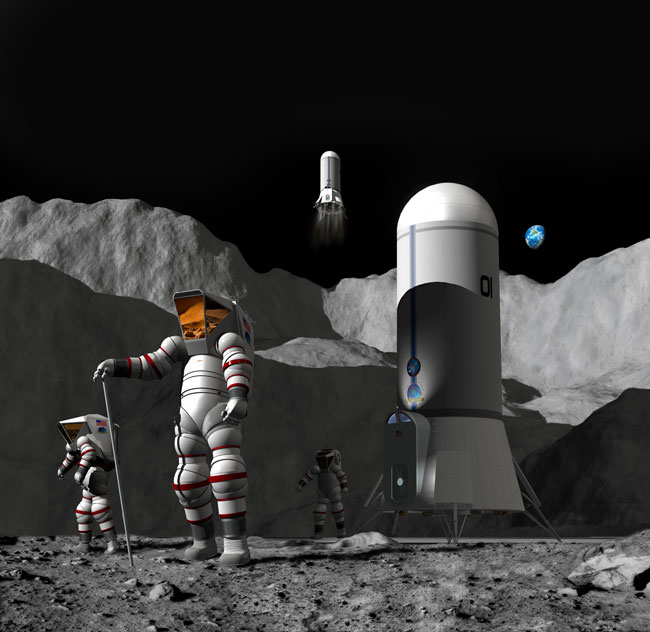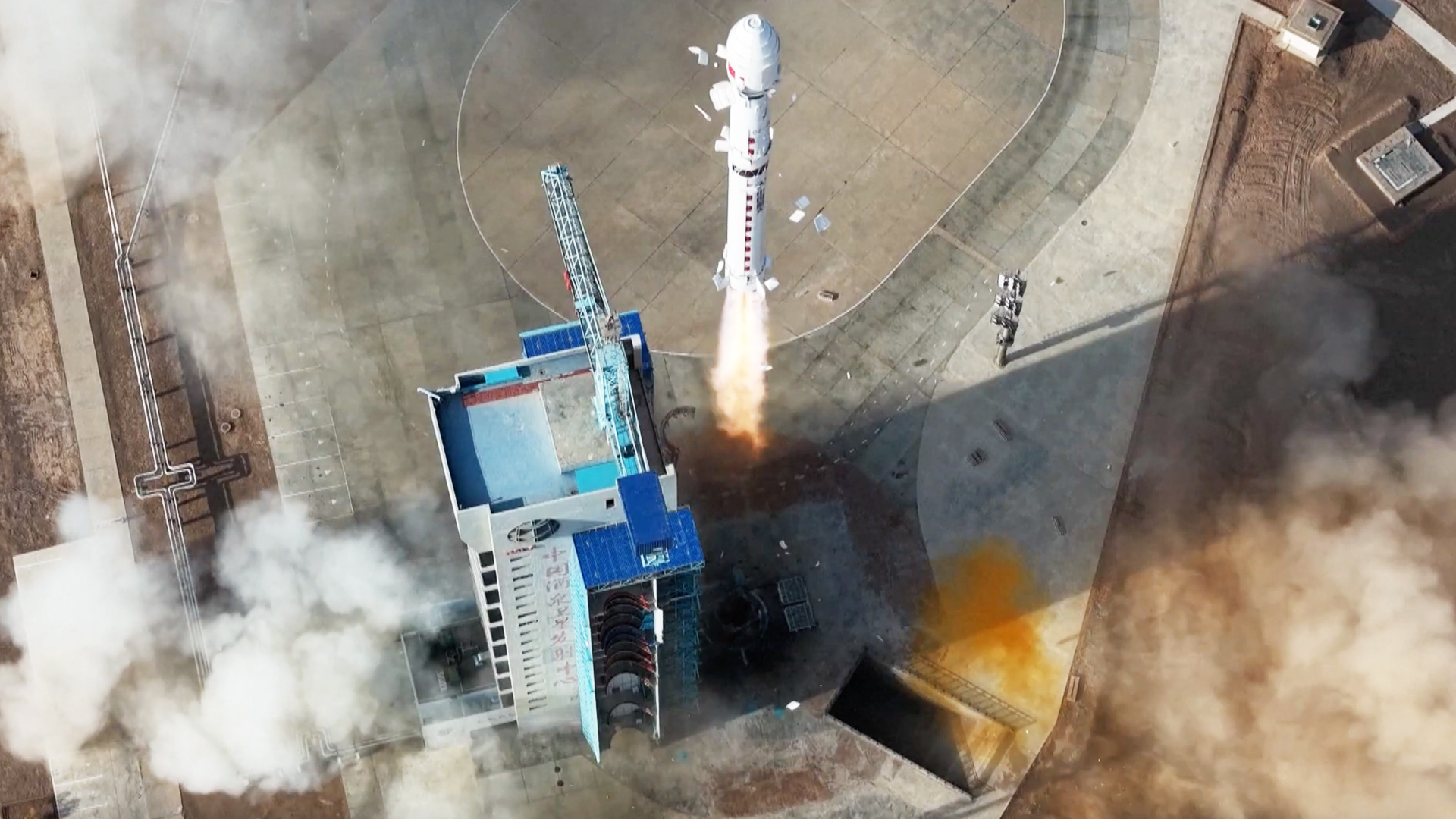A Spiral Stairway to the Moon and Beyond

ORLANDO, Florida -- Replanting boot prints on the Moon. Hurling expeditionary crews to distant and dusty Mars and other destinations. Executing a 21st century outreach campaign to faraway worlds demands a safe, sustainable, and affordable transport vehicle system.
In January 2004, U.S. President George W. Bush set NASA in motion to begin developing a new spaceship to carry humans into Earth orbit and beyond. Tagged the Crew Exploration Vehicle, CEV for short, it would be the first piloted vehicle to explore beyond Earth orbit since the space agency's Apollo glory days.
Though the CEV's main purpose would be to leave Earth orbit, the vehicle is also assigned the duty to ferry astronauts to and from the International Space Station after the space shuttle is phased out. The CEV or versions of the CEV could operate for extended-duration in Earth orbit, as well as in close proximity to or on the surface of the Moon and Mars.
NASA planners have placed this grand slam menu of space exploration goals under the rubric of Constellation Systems. That's the hardware needed to make happen sustained human and robotic surveys of the Moon and Mars, and other targets.
To get things rolling, NASA has already awarded more than a 100 contracts for exploration technologies.
Constellation of Spirals
Collectively known as the "System of Systems", exploration hardware will be developed in a "spiral" or staged approach. There will be early demonstrations and prototypes used to showcase capabilities, certify technologies, and mitigate risk, all along an evolutionary path toward a mature design.
Breaking space news, the latest updates on rocket launches, skywatching events and more!
For example, the first spiral development planned for Constellation Systems is scripted to deliver humans to Earth orbit in a CEV by 2014. The second spiral will dispatch humans to the lunar surface no later than 2020, followed by the third spiral that will enable extended visits to the Moon's cratered landscape.
In this later phase, the Moon becomes an operational analog to try out hardware and procedures for dispatching explorers to Mars after 2020.
And as spiral development evolves, System of Systems elements will also grow to include in-space support systems, destination surface systems, and additional human support systems.
Boilerplate trial runs
Contractors are now busy at work on blueprinting CEV designs. NASA is expected to pick two prime teams later this year for preliminary CEV design and risk reduction flight test programs.
In 2008, the selected contractors will carry out unpiloted "boilerplate" CEV trial runs.
This risk reduction effort will lead NASA CEV project officials to select one contractor in 2008 to build the CEV for Spiral 1. More capable flight tests of the CEV are planned for 2011, also without crew. The first human flight of the CEV is slated for 2014.
Last September, NASA awarded contracts to companies to initiate preliminary concept studies for human lunar exploration and the development of the CEV.
NASA's 1st Space Exploration Conference held here January 30 through February 1 was a technological watering hole for the space agency and contractors to assess work in progress, like the CEV.
Hitting the interim steps
Admittedly, keeping the yearly funding throttle fully open to make real NASA's exploration vision will be a challenge, "but they've got the momentum going," said Boeing's Charles Allen, Vice President, Space Exploration Systems in Arlington, Virginia.
There's beauty in spiral development, Allen told SPACE.com. "If you have a requirement where either the technology is not mature enough or you just can't afford to do it yet, you can roll that into a subsequent spiral."
Doing so, however, means it'll take longer, Allen added, and in the long-term will cost more.
It is critical to meet and perform every milestone and hit the interim steps, said Doug Young, Northrop Grumman Corporate Lead Executive for Project Constellation in El Segundo, California. His company and Boeing are teamed for the CEV and related human lunar exploration systems.
Clearly, moving out on the CEV is an essential step.
Discreet victories
There is no doubt that aerospace teams are primed and ready for the first real stage of NASA's multi-decadal visionary quest.
"We're locked and loaded, yes...but to get the right things on contract so we can define what we want to spend," said John Karas, Vice President for Space Exploration at the Lockheed Martin Space Systems Company in Denver, Colorado.
Karas said that Congress is sensitive to cost overruns and delays as seen on past large space projects. "So as we move forward, we need to have some discreet victories on cost and schedule...like the 2008 CEV demo," he said.
CEV risk reduction actions can involve a spectrum of both ground shakeouts of electronic gear, suborbital test shots, as well as in-orbit evaluation of a CEV design that circles Earth for days, perhaps weeks, Karas said.
Envelope expansion
Risk reduction in the CEV program will demand both technical and cultural processes, Northrop Grumman's Young pointed out. Drawing upon his firm's experience in B2 stealth aircraft development, several years of systematic risk reduction steps were taken in that effort, he added.
Additionally, Young underscored the wake-up call spurred by the loss of shuttle Columbia and its crew in February 2003. That tragedy has forced looks into the cultural aspects of how decisions were or were not made, and how best to manage risk reduction efforts, he said.
"The first thing in mitigating a risk is identifying it," Allen advised. "Sometimes the only option is a completely parallel development...if the technology doesn't mature in time. So you have to have a backup plan. Sometimes that's the only way to do it."
The CEV program calls for a boilerplate type test in 2008, to look at various risk areas, Young said, followed by a non-crewed vehicle flight in 2011, and then movement to crewed CEV operations. Coupled with other space hardware and more functionality, the CEV would then be primed for lunar jaunts.
"In the airplane world, we call that envelope expansion...and risks will be retired over time as well," Young said.
Intellectual capital
CEV is part of an "exploration infrastructure", Young said, akin to the railroads that enabled U.S. expansion westward. He also likened it to America's Interstate Highway System.
"What Project Constellation and CEV are about is creating a capability in the long-term that generates an exponential return in science," Young said.
Boeing's Allen suggested that international cooperation is vital to emplacing all the exploration phases now envisioned. "It's going to require the intellectual capital of all humankind if we're really going to do this right," he added.
There are two ways to achieve international cooperation: Government to government, or begin with industry to industry agreements. "Which form it'll take, I don't know. But this will end up being an international project in the long-term," Allen predicted.
Non-traditional talent
One of the hallmarks of NASA's exploration strategy is to tap the talents of non-traditional space companies.
"They do think differently," said Rear Admiral Craig Steidle (retired), NASA Associate Administrator for the space agency's Exploration Systems Mission Directorate in Washington, D.C.
"They've already influenced our requirements processes. They have provided some very good insight," Steidle told SPACE.com.
For instance, Transformational Space Corporation (t/Space) in Reston, Virginia is a consortium that includes such groups as Burt Rutan's Scaled Composites and Red Whittaker of the Carnegie Mellon Robotics Institute.
A t/Space objective is to demonstrate how the CEV can be developed on an affordable basis by private industry via NASA incentives, saving the government billions of dollars compared to traditional contracting approaches, according to a corporation press release.
Market demand
Also onboard the t/Space team is Princeton University's Edward Belbruno, the inventor of Earth-Moon trajectories with twice the efficiency -- in terms of mass delivered to lunar orbit -- of the trajectories used by NASA in the Apollo program.
David Gump, President of t/Space noted that Belbruno's analysis has proven sound the approach of pairing the CEV with a CEV-derived tanker, thus allowing the CEV to make round trips from low Earth orbit (LEO) to the lunar surface - without requiring the development of a separate lunar lander.
"The market demand of these space-based CEVs -- they need crew, cargo and propellant delivered from Earth to low Earth orbit -- can invigorate a truly competitive commercial launch industry," Gump concluded.
How important is it for NASA to involve such groups as t/Space in devising a credible space vision, contrasted to solely relying on the tried-and-true "big league" aerospace firms?
"I think Congress wants to see NASA reduce the schedule and cost risk of the standard prime approach by including a nontraditional company that uses rapid prototyping techniques and lean staffing," Gump responded to a SPACE.com email inquiry.
"After all, the only U.S. company to put astronauts into space this past year was one of our contractors, Scaled Composites, and not any of the traditional primes," Gump explained. "Congress wants to see this nontraditional talent put to work in the Exploration Vision."

Leonard David is an award-winning space journalist who has been reporting on space activities for more than 50 years. Currently writing as Space.com's Space Insider Columnist among his other projects, Leonard has authored numerous books on space exploration, Mars missions and more, with his latest being "Moon Rush: The New Space Race" published in 2019 by National Geographic. He also wrote "Mars: Our Future on the Red Planet" released in 2016 by National Geographic. Leonard has served as a correspondent for SpaceNews, Scientific American and Aerospace America for the AIAA. He has received many awards, including the first Ordway Award for Sustained Excellence in Spaceflight History in 2015 at the AAS Wernher von Braun Memorial Symposium. You can find out Leonard's latest project at his website and on Twitter.
